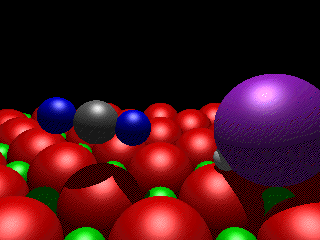
Photo-initiated Surface Aligned Reaction of HBr + CO2 on LiF(001)
A quasi-classical trajectory study of a chemical reaction between H and CO2 at the LiF(001) surface is carried out. The reaction is initiated by photodissociation of well-aligned HBr(ad) at 193 nm, which produces a 'hot' H atom directed towards a nearby CO2(ad). Single molecules of each reactant are placed on a static surface and a full dimensional HCO2 potential derived from ab initio calculations is used. The adsorbate-substrate and the adsorbate-adsorbate potentials consist of both non-electrostatic and electrostatic contributions. Several energetically favorable adsorption configurations representative of low coverage conditions are determined by a Monte Carlo method. Quasi-classical trajectories are calculated at 80 K for four different adsorption configurations. We find that the reactivity at some configurations is significantly enhanced compared with the corresponding gas phase simulation. The calculated impact parameters and incident angles of the surface-aligned collisions indicate that the enhanced reactivity can be largely attributed to the closeness and alignment of the co-adsorbates on the surface. Product distributions, with the exception of a departure angle, show little memory with regard to the initial configuration and are similar to those obtained in the gas phase. A significant number of the unreacted hydrogen atoms retain sufficient energy to make subsequent reaction with other co-adsorbates a possibility. We find evidence of several dynamic features pertinent to the use of the surface as a template for reactivity enhancement, including scattering at the surface, the squeezed atom effect, chattering, and caging.
Very recently, the same reaction has been investigated using a moveable surface model [2]. In this work, we address the roles played by surface motion and temperature. Our results indicate that some (~0.3 eV) energy can be lost to the surface either from the adsorbed HOCO complex or from one of the products when it collides with the surface during the final disintegration of the HOCO complex. However, the energy transfer has a minor effect on the reactivity. The final state distributions of the products are found to be similar to those produced with the static surface model. On the other hand, a significant temperature effect is predicted for one adsorbate configuration. Apparently, the lowering of temperature for a well-aligned system results in a more narrowly focused alignment and higher reactivity.
References:
[1] J. V. Setzler, H. Guo, and G. C. Schatz, J. Phys. Chem., B101, 5352 (1997). Photo-initiated chemical reactions dynamics between aligned adsorates on solid surfaces: H + CO2.
[2] J. V. Setzler, J. Bechtel, H. Guo and G. C. Schatz, J. Chem. Phys., 107, 9176 (1997). A further theoretical exploration of the surface-aligned photo-initiated H + CO2 reaction: Surface motion and temperature dependence.

Quicktime Movies (Warning: download of the long version could take a long time)
A reactive trajectory on static surface [Short version]
A reactive trajectory on static surface [Long version]
A reactive trajectory on movable surface [Long version]
Back to: main page